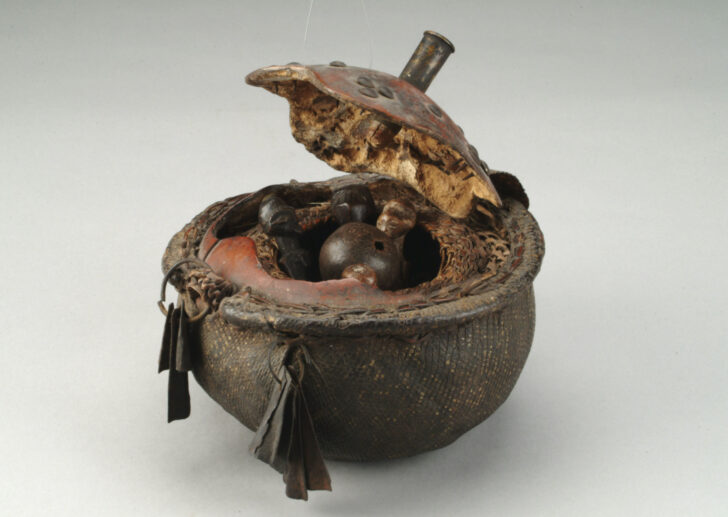Calabash (kileu)
Southwestern Songye (Democratic Republic of the Congo)

Description
Spring-Summer 2017 Gallery Rotation Label:
This hollowed-out gourd, covered with snakeskin, is filled with a variety of materials that allowed a Songye spiritual leader (nganga) to communicate with his community’s ancestors. Inside the calabash, materials symbolizing power such as bird feathers, claws, seedpods and metal tacks, are joined by miniature carvings representing Songye ancestors. Brass tacks and dangling metal bells enhance the calabash’s power to connect to the spirits.
People consulted a nganga for assistance with various personal and communal problems, including issues of health and protection. To activate the gourd’s power and to enable communication with the spirits, he would have shaken the calabash, moving the objects inside. The messages attached to each element evolved as their physical relationship to other objects changed. The nganga was skilled in decoding these multiple meanings and translating their significance to his client, acting as a messenger, advisor, or judge.
Subject Matter:
This divination calabash (kileu) is attributed to the southwestern Songye people, who were based in what is now the Democratic Republic of the Congo. Divination as a way to receive oracular knowledge was widely practiced throughout central Africa, and often the diviner was second only to the chief in status. For the Songye, the diviner, or nganga, served as a clairvoyant mediator transversing the temporal and spiritual realms. Able to communicate with unseen forces, the nganga aided community members by offering them diagnoses and treatments for both individual and societal crises and afflictions.
A Songye client faced with a dilemma would consult an nganga who would shake a divination vessel, in the form of a calabash or basket, filled with seemingly eclectic objects, both natural and manufactured. These items, however, are laden with rich symbolism, and when shaken, their physical juxtapositions within the vessel would disclose special, coded meanings which could be exclusively interpreted by the nganga on behalf of the client. This particular calabash, for instance, holds the following organic matter: bird claws, feathers, wings, split cane, and dried seeds. Also present within the calabash are several small, wooden anthropomorphic figurines reminiscent of Songye mankishi (sing. nkishi), or power figures, and likely representing the spirits of deceased diviners, whom the nganga appeals to for guidance, or other ancestral spirits. Iron clappers suspended from the sides of the calabash would dangle upon shaking, creating a sonic cue summoning these invisible spirits.
Physical Description:
This vessel is formed from a hollowed calabash or gourd, the top of which has been carved to form a lid, decoratively patterned with brass tacks and studded by a handle at the center. Snake skin covers the rounded base of the calabash conferring a coarse texture. Several holes have been drilled around the top perimeter of the base from which metal rings holding iron clappers or bells dangle. An array of man-made, animal, and vegetal objects are held inside the vessel, namely, small, wooden anthropomorphic figurines carved with a minimum of physiognomic detail, bird claws, feathers, wings, split cane, and dried seeds.
Usage Rights:
If you are interested in using an image for a publication, please visit https://umma.umich.edu/request-image/ for more information and to fill out the online Image Rights and Reproductions Request Form.